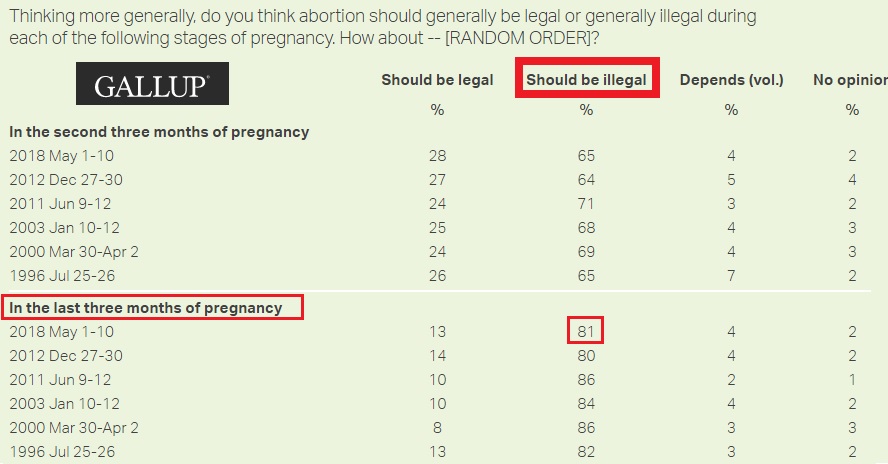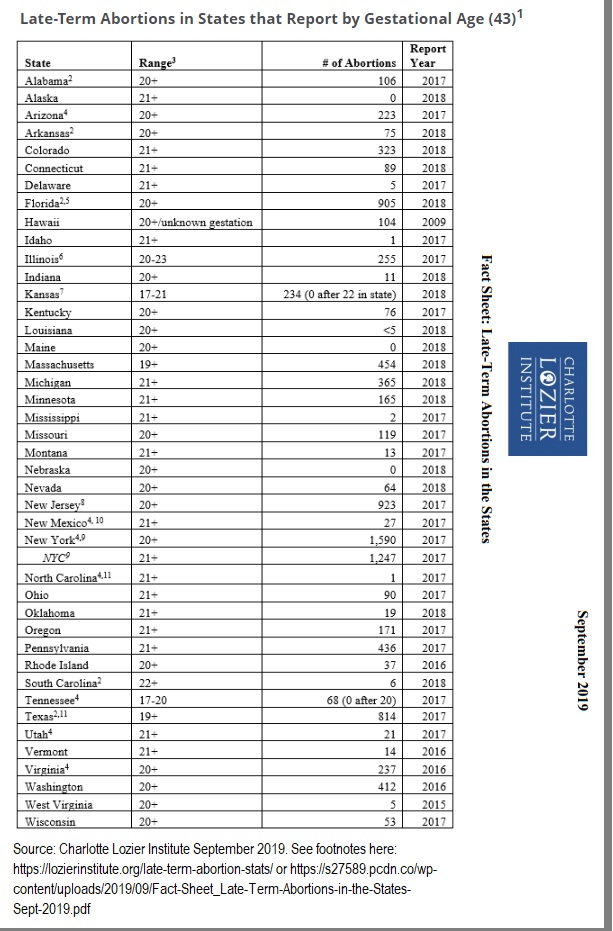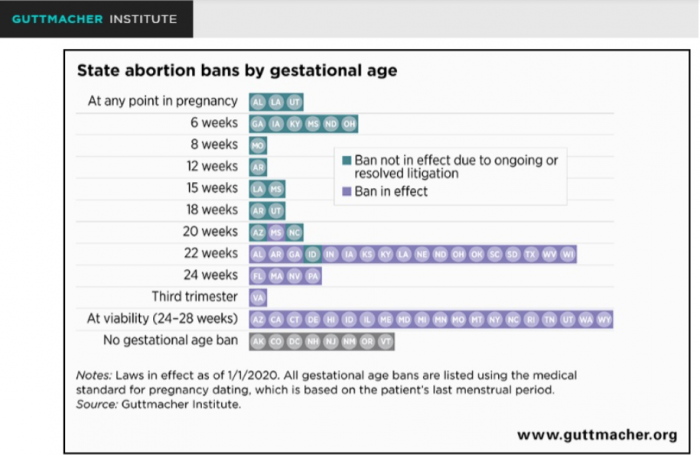Despite American opposition to late-term abortions, these barbaric procedures occur more frequently in the United States than most people realize. Years of polling conducted by Gallup have found that Americans consistently oppose abortion later in pregnancy. As recently as January 2020, a Marist poll commissioned by the Knights of Columbus found that a majority of Americans want to ban abortion after 20 weeks of pregnancy. It also found that “7 in 10 Americans would limit abortion to, at most, the first three months of pregnancy. The 70% number is identical to last summer’s NPR/PBS NewsHour/Marist Poll,” KOFC.org noted. However, a 2021 Marist poll found that this number had increased to 76%.

Gallup polling on late abortion
1. How many late-term abortions really happen?
Live Action News previously documented that abortions committed in the second and third trimesters together totaled over 100,000 in 2017 alone. Neither of the national reporting agencies — the Centers for Disease Control (CDC) and the Guttmacher Institute — specify abortions by weeks in the third trimester; however, they both acknowledge that abortions committed at 21 weeks or greater represent 1% to 1.3% of all reported abortions. Despite this flaw, what both reporting agencies tell us is that abortions committed at or beyond 21 weeks are far from insignificant.
The data shows:
- 6,196 (estimated) late-term abortions in 2018 (CDC).
- 7,481 (estimated) late-term abortions in 2016 (CDC).
- 11,210 (estimated) late-term abortions in 2017 (Guttmacher).
Abortion procedures at this stage include D&E — a violent type of dismemberment abortion — described in the video below. Another form is called induction abortion. Read more about that gruesome procedure here.
A Live Action News analysis of data from state reporting agencies that list statistics by gestation revealed:
- In three states, 2nd and 3rd trimester abortions accounted for 13-17% of all abortions.
- In 12 states, 2nd and 3rd trimester abortions accounted for 11-13% of all abortions.
- In 19 states, 2nd and 3rd trimester abortions accounted for 6-10% of all abortions.
A September 2019 analysis of states reporting by gestation, published by the Charlotte Lozier Institute, found significant numbers of late abortions. Note the overall total differs from national estimates mentioned previously because 1) the state report may have been released after the national report or 2) Guttmacher surveys each abortion provider and rely on reported data alone.

Late term abortions by state (Graph: Charlotte Lozier Institute Sept 2019)
2. Who commits late-term abortions?
- According to Guttmacher’s 2017 report, 25% of abortion facilities offered abortions up to 20 weeks and 10% up to 24 weeks.
- There are facilities which provide abortions even later in gestation.
- Planned Parenthood commits elective abortions up to the 24th week and opposes late-term abortion restrictions.
- A 2020 analysis by the Abortion Care Network (ACN) reported that independent abortion facilites made up 66% of all facilities committing abortion beyond 16 weeks, 71% of clinics committing abortion beyond 19 weeks and 81% of those committing abortion after 22 weeks.
3. Which states allow abortion up to birth?
- On the federal level, Roe v. Wade and its companion case, Doe v. Bolton, have made it clear that abortions in all months of pregnancy for “health reasons” are legal.
- Live Action News previously reported, “As defined by the Supreme Court’s rulings in Roe v. Wade and Doe v. Bolton, “health” can mean “physical, emotional, psychological, familial”…. These provisions—which are rarely mentioned by media outlets—provide broad leeway to perform abortions in practically every case….”
While Roe made a provision for states to limit abortion after the second trimester, abortion advocates are working tirelessly to lift any and all gestational restrictions to allow abortion at a point in pregnancy when it has been documented that a preborn child feels pain.
A December 2020 analysis by Guttmacher Institute found that:
- 43 states prohibit some abortions after a certain point in pregnancy.
- 22 states ban abortion between 13 and 24 weeks LMP.
- 1 state bans abortion at 20 weeks LMP (18 weeks postfertilization in state law).
- 17 states ban abortion at 22 weeks LMP (20 weeks postfertilization in state law) on the unscientific grounds that a fetus can feel pain at that point.
- 4 states ban abortion at 24 weeks LMP.
- 20 states impose a ban at viability.
- 1 state imposes a ban in the third trimester (25 weeks LMP onward)
Live Action News has tracked several bills that allow abortion up to birth in the following states:
- Illinois: The Illinois Reproductive Health Act, passed in 2019, does away with the state’s ban on partial-birth abortion, allows for abortion at any time, for any reason, including for reasons of “health,” and struck down several important regulations. Abortionists have made clear that they believe the very state of being pregnant and not wanting to be is reason enough to commit an abortion.
- New Mexico: In 2019, the New Mexico state House of Representatives passed HB-51, an extreme bill that allows abortion up to birth.
- New Jersey: In 2020, lawmakers introduced a bill that would permanently
enshrine abortion as a right in the state throughout pregnancy. - New York: On January 22, 2019, New York lit up One World Trade Center in pink to celebrate the passage of the Reproductive Health Act (RHA), which codifies Roe v. Wade, allowing unfettered abortion up to birth, even for reasons of the mother’s broadly defined “health.”
- Rhode Island: A law recently passed in RI made abortion is legal without restriction up until “viability” — the point when a child could survive outside the womb (a point that depends largely upon available medical technology, but is often around 22-24 weeks gestation, or 20-22 weeks post-fertilization). After that point, it is legal until birth “when necessary to preserve the health or life” of the mother — which is completely unnecessary, since at that point it would be much safer for the mother to have an emergency C-section than a days-long abortion procedure. The child is viable and therefore would have a good chance of surviving.
- Vermont: Last year, the Vermont House…gave preliminary approval to an expansive bill that will ensure legal abortion through all nine months of pregnancy with zero restrictions.
4. Why do women get late-term abortions?
The abortion industry has admitted that abortion later in pregnancy is frequently committed on healthy babies. Even the late abortionist George Tiller conceded late-term abortions are legal under the Roe v. Wade and Doe v. Bolton Supreme Court decisions: “[…W]e are able to use the wide definition and the full implementation of Roe v Wade decision which allows us to do post viability terminations of pregnancy.”
Live Action News previously documented how late-term abortionist Warren Hern declared, “I say every pregnancy carries a risk of death,” and “I will certify that any pregnancy is a threat to a woman’s life and could cause grievous injury to her physical health.” Previously unearthed testimony from a 2015 court case revealed that Planned Parenthood considers all abortions to be “medically necessary.”
A teaching module published by an abortion training program at the UCSF Bixby Center for Global Reproductive Health reveals that physical health is almost never given as a reason for why a woman aborts after the first trimester. One study cited the case of a “26-year-old Latina woman in New Mexico, who had an abortion at 28 weeks’ gestation, [saying], ‘I was afraid of my boyfriend finding out, and I went [to the abortion facility] once he was in jail.’”
Despite the misplaced abortion enthusiasm of some politicians, the aforementioned Marist poll reveals, “[A] notable proportion (41%) of those who identify as pro-choice are more likely to vote for candidates who support restrictions, as are more than nine in 10 who identify as pro-life (96%).”
“Like” Live Action News on Facebook for more pro-life news and commentary!








